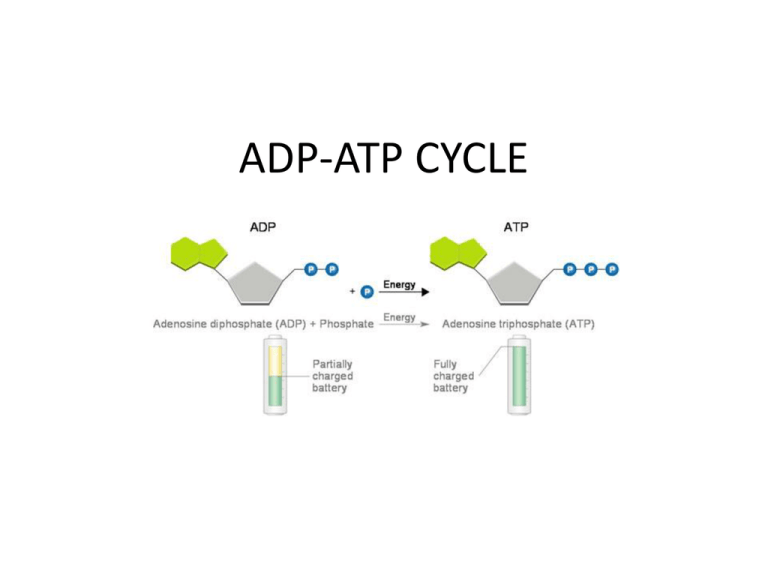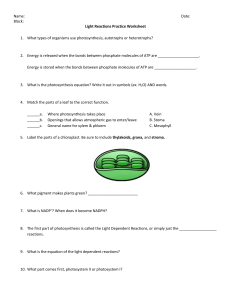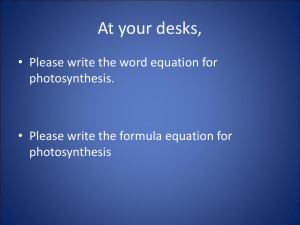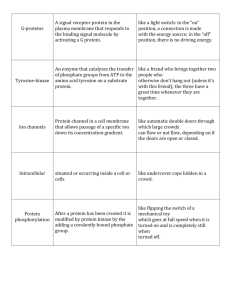ADP-ATP CYCLE
advertisement

ADP-ATP CYCLE ATP structure • Adenosine triphosphate (ATP) is the most important biological molecule that supplies energy to the cell. A molecule of ATP is composed of three parts: • · A nitrogenous base (adenine) • · A sugar (ribose) • · Three phosphate groups (therefore the name triphosphate) bonded together by “high energy” bonds ATP Structure ADP-ATP Cycle • · Cells break phosphate bonds as needed to supply energy for most cellular functions, leaving adenosine diphosphate (ADP) and a phosphate available for reuse. • ○ When any of the phosphate bonds are broken or formed, energy is involved. • ¨ Energy is released each time a phosphate is removed from the molecule. • ¨ Energy is used each time a phosphate attaches to the molecule. • ○ To constantly supply the cell with energy, the ADP is recycled creating more ATP which carries much more energy than ADP. ADP-ATP CYCLE CONTINUED • · The steps in the ATP-ADP cycle are • To supply cells with energy, a “high energy” bond in ATP is broken. ADP is formed and a phosphate is released back into the cytoplasm. • ATP → ADP + phosphate + energy • As the cell requires more energy, ADP becomes ATP when a free phosphate attaches to the ADP molecule. The energy required to attach the phosphate to ADP is much less than the energy produced when the phosphate bond is broken. ADP + phosphate + energy → ATP General Overview of Photosynthesis • The process photosynthesis occurs in the organelle called the Chloroplast and is generally represented using a balanced chemical equation. However, this equation does not represent all of the steps that occur during the process of photosynthesis. • EQUATION: • · In general, six carbon dioxide molecules and six water molecules are needed to produce one glucose molecule and six oxygen molecules. • · Each of the reactants (carbon dioxide and water) is broken down at different stages of the process. • · Each of the products (oxygen and glucose) is formed in different stages of the process. • · Solar energy is needed to break down the water molecules. Chloroplast Structure Photosynthesis • Photosynthesis is composed of two stages: 1. light-dependent reactions, 2.dark (light-independent) reactions • All organisms need a constant source of energy to survive. The ultimate source of energy for most life on Earth is the Sun. • Photosynthesis is the overall process by which sunlight (solar energy) chemically converts water and carbon dioxide into chemical energy stored in simple sugars (glucose). Light Dependant Reaction • · The first stage is called the light-dependent reactions because they require solar energy. • The light dependant reaction occurs in the Thylakoid membrane of the Chloroplast. • -During the light-dependent reactions, solar energy is absorbed by chloroplasts and two energy storing molecules (ATP and NADPH) are produced. • - The solar energy is used to split water molecules which results in the release of oxygen as a waste product, an essential step in the process of photosynthesis. Products of the Light Dependant Reaction • The Light Dependant reaction produces: 1. Oxygen 2. NADPH-Energy Storing Molecule 3. ATP-Energy Storing Molecule The Light Independent Reaction (Dark Reaction) • · The second stage is called the dark (light-independent) reactions because they do not require solar energy. • The Light Independent reaction occurs in the Stroma of the chloroplast. • - During the dark (light-independent) reactions, energy stored in ATP and NADPH is used to produce simple sugars (such as glucose) from carbon dioxide. These simple sugars are used to store chemical energy for use by the cells at later times. • - Glucose can be used as an energy source through the process of cellular respiration or it can be converted to organic molecules (such as proteins, carbohydrates, fats/lipids, or cellulose) by various biologic processes. Products of the Light Independent Reaction • Glucose • Other organic molecules such as lipids, proteins, cellulose or carbohydrates by other biological processes. Summary of Photosynthesis




